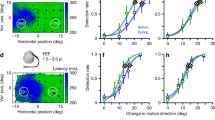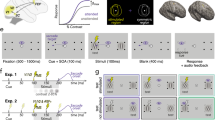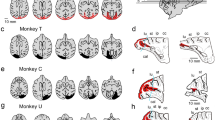Abstract
The macaque frontal eye field (FEF) is involved in the generation of saccadic eye movements and fixations. To better understand the role of the FEF, we reversibly inactivated a portion of it while a monkey made saccades and fixations in response to visual stimuli. Lidocaine was infused into a FEF and neural inactivation was monitored with a nearby microelectrode. We used two saccadic tasks. In the delay task, a target was presented and then extinguished, but the monkey was not allowed to make a saccade to its location until a cue to move was given. In the step task, the monkey was allowed to look at a target as soon as it appeared. During FEF inactivation, monkeys were severely impaired at making saccades to locations of extinguished contralateral targets in the delay task. They were similarly impaired at making saccades to locations of contralateral targets in the step task if the target was flashed for ≤100 ms, such that it was gone before the saccade was initiated. Deficits included increases in saccadic latency, increases in saccadic error, and increases in the frequency of trials in which a saccade was not made. We varied the initial fixation location and found that the impairment specifically affected contraversive saccades rather than affecting all saccades made into head-centered contralateral space. Monkeys were impaired only slightly at making saccades to contralateral targets in the step task if the target duration was 1000 ms, such that the target was present during the saccade: latency increased, but increases in saccadic error were mild and increases in the frequency of trials in which a saccade was not made were insignificant. During FEF inactivation there usually was a direct correlation between the latency and the error of saccades made in response to contralateral targets. In the delay task, FEF inactivation increased the frequency of making premature saccades to ipsilateral targets. FEF inactivation had inconsistent and mild effects on saccadic peak velocity. FEF inactivation caused impairments in the ability to fixate lights steadily in contralateral space. FEF inactivation always caused an ipsiversive deviation of the eyes in darkness. In summary, our results suggest that the FEF plays major roles in (1) generating contraversive saccades to locations of extinguished or flashed targets, (2) maintaining contralateral fixations, and (3) suppressing inappropriate ipsiversive saccades.
Similar content being viewed by others
Author information
Authors and Affiliations
Additional information
Received: 2 February 1996 / Accepted: 26 February 1997
Rights and permissions
About this article
Cite this article
Sommer, M., Tehovnik, E. Reversible inactivation of macaque frontal eye field. Exp Brain Res 116, 229–249 (1997). https://doi.org/10.1007/PL00005752
Issue Date:
DOI: https://doi.org/10.1007/PL00005752




